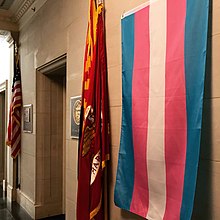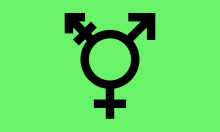Helms' design

The most prominent transgender flag design is the "Transgender Pride Flag", used as a symbol of transgender pride and diversity, and transgender rights. The flag was created by American trans woman Monica Helms in 1999, and was first shown at a pride parade in Phoenix, Arizona, in 2000. Helms describes the meaning of the transgender pride flag as follows:
The stripes at the top and bottom are light blue, the traditional masculine color. The stripes next to them are pink, the traditional feminine color. The stripe in the middle is white, for those who are transitioning or consider themselves having a neutral or undefined gender.
Usage
In the United Kingdom, Brighton and Hove council flies this flag on the Transgender Day of Remembrance. Transport for London also flew the flag from London Underground's 55 Broadway Headquarters for the 2016 Transgender Awareness Week.
The flag was flown from the large public flagpole in San Francisco's Castro District (where the rainbow flag usually flies) for the first time on 19 and 20 November 2012 in commemoration of the Transgender Day of Remembrance. The flag-raising ceremony was presided over by local drag queen La Monistat.
On 19 August 2014, Monica Helms donated the original transgender pride flag to the Smithsonian National Museum of American History.
Philadelphia became the first county government in the US to officially raise the transgender pride flag in 2015. It was raised at City Hall in honor of Philadelphia's 14th Annual Trans Health Conference, and remained next to the US and City of Philadelphia flags for the entirety of the conference. Then-Mayor Michael Nutter gave a speech in honor of the trans community's acceptance in Philadelphia.

In January 2019, Virginia Representative Jennifer Wexton hung the transgender pride flag outside her office in Washington, D.C., in a move to show support for the transgender community. In March 2019, dozens of Democratic and independent members of Congress flew the flag outside their offices for Trans Visibility Week leading up to the International Transgender Day of Visibility.
The flag flew above US state capitol buildings for the first time on Transgender Day of Remembrance 2019. The Iowa State Capitol and California State Capitol displayed the flag.
An emoji version of the flag was added to the standard Emoji listing in 2020. The transgender flag emoji (🏳️⚧️) consists of a sequence of five Unicode code points: U+1F3F3 🏳 WAVING WHITE FLAG, U+FE0F ️ VARIATION SELECTOR-16, U+200D ZERO WIDTH JOINER, U+26A7 ⚧ MALE WITH STROKE AND MALE AND FEMALE SIGN, U+FE0F ️ VARIATION SELECTOR-16.
Variations
In addition to Helms' original transgender pride flag design, a number of communities have created their variation on the flag, adding symbols or elements to reflect aspects of transgender identity, such as the canton of the Flag of the United States being added to create a flag representing transgender American identity.
Alternative designs
Over the years, several transgender flags have been adopted by various transgender individuals, organizations and communities.
Pellinen design

Jennifer Pellinen designed this flag in 2002 unaware of the more widely-used Helms design. Pellinen describes it thusly:
"I came up with the idea for the transgender flag a few years ago. At the time I did not know of any other flag designs. The design was created for TG pride. Another reason I made the flag is that most cross dressers are not gay. If they use the rainbow flag people will think they are gay. The colors on the flag are from top to bottom. Pink, light purple, medium purple, dark purple, and blue. The pink and the blue represent male and female. The 3 purple stripes represent the diversity of the TG community as well as genders other than male and female."
Israeli flag

A unique design is used in Israel by the transgender and genderqueer community. This flag has a neon green background (to stand out in public places) and a centred Venus, Mars, and Mars with stroke symbol in black to represent transgender people.
Lindsay design

In Ontario a flag known as the "Trans Flag", created by Ottawa graphic designer Michelle Lindsay, is used. It consists of two stripes, the top in Sunset Magenta representing female, and the bottom in Ocean Blue representing male, with a tripled Venus, Mars, and Mars with stroke symbol representing transgender people, overlaying them.
This Trans Flag was first used by the Ottawa-area trans community for Ottawa's 2010 edition of the Trans Day of Remembrance. This event included a ceremony in which the Ottawa Police unveiled and raised this flag. The ceremony was repeated during the 2011 Ottawa and Gatineau editions of the Trans Day of Remembrance, this time joined by the Ottawa Paramedics, Ottawa City Hall and Gatineau City Hall also raising the Trans Flag during their own ceremonies. The list of groups doing official unfurling/raising of the Trans Flag in the Ottawa-Gatineau area as part of their Trans Day of Remembrance has grown each year. The Trans Flag has also been used as part of the Peterborough Pride Parade.
Andrew design

In 1999, San Francisco trans man Johnathan Andrew, under the moniker of "Captain John" on his female-to-male trans website "Adventures in Boyland", designed and published a flag for those within the transgender community. This trans pride flag consists of seven stripes alternating in light pink and light blue separated by thin white stripes and featuring, in the upper left hoist, a twinned Venus and Mars symbol in lavender. The repeated explanation of the color symbolism for Monica Helms' more well-known flag design is remarkably similar/almost identical to that of the description of Andrew's design on other pages. The original description for Andrew's trans pride flag read:
And finally, an AiB Exclusive—the Transgender Pride Flag (c)1999. Yes, indeedy—it's about time we had our own symbol to represent the community, ain't it? Bears have theirs. Leathermen have theirs. Why can't we have ours? And might we say that we feel these designs, designed by your friendly neighborhood Captain, embodies all aspects of our identities. Whether we're transgender or transsexual, going from male (blue) to female (pink) or from female (pink) to male (blue), or just somewhere in between, both flag designs capture the subtlties and the strengths of our spirits (and the white accents in between the lines are the—supposedly—the little triumphs that happen upon us during our journies [sic] to become whole (the flag as a whole)). The lavender-colored sex symbol—not to be confused with The Artist Currently Not Known as Purple's symbol—can also designate FtM/MtF/or Intersexed/Both/Shifting. As you can see, both flag designs/symbols can be used to encompass all types of gender variation. Hell, who knows, maybe it just might catch on (and Cpt. John will be elated—even more so when he get [sic] credit for the design).
Andrew explained his motivation for creating the flag in 2017:
I designed this flag at the time because back then, there was nothing for us besides the standard rainbow flag, the bear pride flag, the leather pride flag. Before Google existed in the capacity that it does today, I deep-searched the internet to see if I could find a trans pride flag and found none, so as an artist/designer, designed one myself for our community. The flag itself was meant to represent the [trans] community as a whole, with the twinned symbol representing our journey and the qualities that we possess. I published the design on my site as "the first trans pride flag", and some trans sites picked it up. We were all a tight-knit community of sites back then, linking to each other through pride webrings. Though it was my desire, I never had the funds to get it produced.
Kaleidoscope
In 2014, a new transgender flag known as the "Trans Kaleidoscope" was created by members of the Toronto Trans Alliance (TTA). It was raised at the first Transgender Day of Remembrance ceremony at Toronto City Hall on 20 November 2014. Controversially, TTA members voted for this flag rather than the Helms and Lindsay flags, which some felt didn’t represent them. The flag has not received significant usage since the event. The Trans Kaleidoscope is described on the TTA web site as representing "the range of gender identities across the spectrum", with the individual colours representing:
- Pink: women/femaleness
- Purple: those who feel their gender identity is a combination of male and female
- Green: those who feel their gender identity is neither male nor female
- Blue: men/maleness
- Yellow: intersex
"The new white symbol with a black border is an extension of the Trans symbol with the male and female symbols, a combined symbol representing those with a gender identity combining male and female and a plain pole (with neither arrow nor bar) representing those with a gender identity that is neither male nor female, embodying awareness and inclusion of all."
